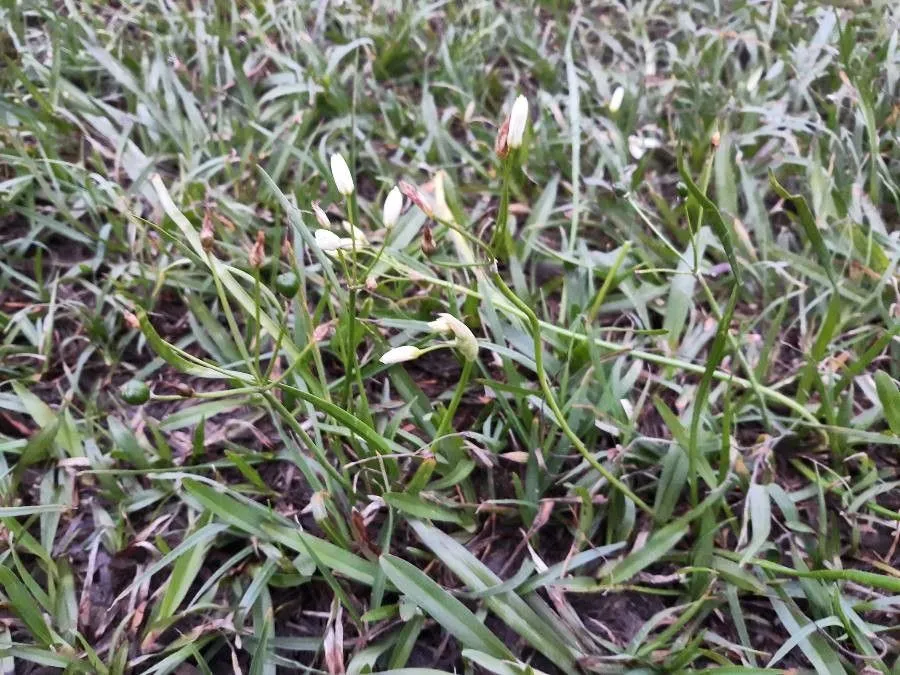
Author: (L.) Britton
Bibliography: N.L.Britton & A.Brown, Ill. Fl. N. U.S. 1: 415 (1896)
Year: 1896
Status: accepted
Rank: species
Genus: Nothoscordum
Vegetable: False
Observations: Temp. & Subtrop. America
Crow-poison, scientifically known as Nothoscordum bivalve, is a captivating plant that belongs to the Amaryllidaceae family. This plant is prominently found in temperate and subtropical regions of America, where it thrives in various environments.
First described comprehensively in 1896 by N.L. Britton and A. Brown in their work “Illustrated Flora of the Northern United States,” Crow-poison has since captivated botanists and plant enthusiasts alike. The descriptive work, particularly highlighted on page 415 of their publication, laid the groundwork for understanding this unique species.
Crow-poison is particularly notable for its striking appearance. It typically showcases petite flowers that are often white or cream-colored, growing in umbels on slender, erect stems. These delicate blooms are not only attractive but also indicative of the plant’s adaptation to its environments.
Despite its common name, Crow-poison is not particularly harmful to birds. The name may originate from historical anecdotes or misconceptions about the plant’s effects. In fact, it’s a member of the Amaryllidaceae family, which is known for encompassing many ornamental plants commonly found in gardens.
The breadth of its habitat across temperate and subtropical regions underscores the plant’s adaptability. Crow-poison can typically be found in open woodlands, meadows, and sometimes even in disturbed areas where it has become naturalized.
Overall, Crow-poison is a fascinating and beautiful part of the botanical world, contributing to both natural ecosystems and cultivated landscapes. Its resilient nature and charming flowers make it a plant worth noting for both scientific study and horticultural enjoyment.
Eng: crow-poison, crowpoison, false garlic
Hun: alacsony szagtalanhagyma
En: Crow-poison, False garlic, Crowpoison
Hu: Alacsony szagtalanhagyma
Taken Apr 12, 2021 by Jose Antonio Sanchez Segarra (cc-by-sa)
Taken Oct 19, 2021 by Carmen Diaz (cc-by-sa)
Taken Apr 12, 2022 by lakajk (cc-by-sa)
Taken Mar 16, 2021 by Safran Astra (cc-by-sa)
Taken Nov 20, 2021 by Oliveira Vander (cc-by-sa)
Taken Jan 1, 1900 by EOL − Gerrit Davidse (cc-by-nc-sa)
Taken Mar 24, 2012 by EOL − Ron Thomas (cc-by-nc-sa)
Taken Jan 1, 1900 by EOL − Gerrit Davidse (cc-by-nc-sa)
Taken Jan 1, 1900 by EOL − Gerrit Davidse (cc-by-nc-sa)
Taken Mar 28, 2021 by Eli Small (cc-by-sa)
Taken Mar 24, 2021 by heyrenee (cc-by-sa)
Taken Apr 20, 2020 by Kendra RaiderNature (cc-by-sa)
Taken May 9, 2022 by Ross Kat (cc-by-sa)
Taken May 23, 2020 by Ale P (cc-by-sa)
Taken Mar 28, 2021 by Eli Small (cc-by-sa)
Taken Apr 20, 2020 by Kendra RaiderNature (cc-by-sa)
Taken Jun 4, 2021 by tamer abbara (cc-by-sa)
Taken Jun 4, 2021 by tamer abbara (cc-by-sa)
Taken May 8, 2020 by Ko Ko (cc-by-sa)
Taken Mar 21, 2016 by EOL − Sam Kieschnick (cc-by-nc)
Taken Mar 21, 2016 by EOL − anewman (cc-by-nc)
Taken Mar 3, 2016 by EOL − Linda Jo Conn (cc-by-nc)
Taken Mar 4, 2016 by EOL − Nina (cc-by-nc)
Taken Mar 5, 2016 by EOL − Linda Jo Conn (cc-by-nc)
© copyright of the Board of Trustees of the Royal Botanic Gardens, Kew.
© copyright of the Board of Trustees of the Royal Botanic Gardens, Kew.
© copyright of the Board of Trustees of the Royal Botanic Gardens, Kew.
Growth habit: Forb/herb
Family: Myrtaceae Author: (F.Muell.) K.D.Hill & L.A.S.Johnson Bibliography: Telopea 6: 402 (1995) Year: 1995 Status:…
Family: Rubiaceae Author: Pierre ex A.Froehner Bibliography: Notizbl. Bot. Gart. Berlin-Dahlem 1: 237 (1897) Year:…
Family: Sapindaceae Author: Koidz. Bibliography: J. Coll. Sci. Imp. Univ. Tokyo 32(1): 38 (1911) Year:…
Family: Asteraceae Author: A.Gray Bibliography: Pacif. Railr. Rep.: 107 (1857) Year: 1857 Status: accepted Rank:…
Family: Fabaceae Author: Medik. Bibliography: Vorles. Churpfälz. Phys.-Ökon. Ges. 2: 398 (1787) Year: 1787 Status:…
Family: Aspleniaceae Author: (Cav.) Alston Bibliography: Bull. Misc. Inform. Kew 1932: 309 (1932) Year: 1932…